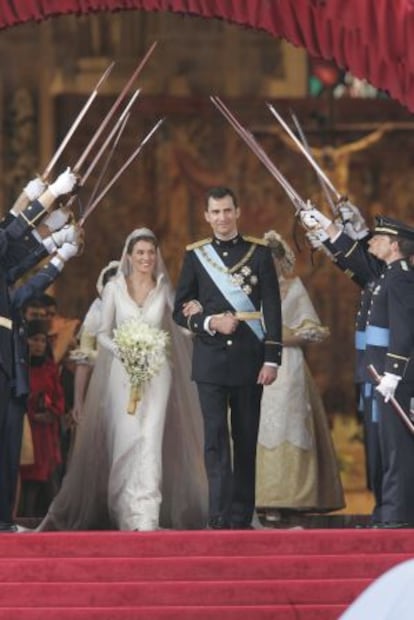How Spain’s Princess Letizia took on her royal challenge
Ex-newsreader faced a steep learning curve after marrying Prince Felipe a decade ago Since then she has found success abroad and carved out niches in education, innovation and health

May 22 marks the 10th wedding anniversary of Prince Felipe de Borbón and Letizia Ortiz. The couple’s marriage is a very European one: like his fellow royals in the United Kingdom, Sweden, Denmark and Monaco, the future King of Spain chose to marry a commoner. Princess Letizia grew up in a middle-class family, attended a public university, and then made a career for herself in the media, becoming one of the country’s best-known newsreaders in the 1990s.
The royal couple’s two children, Leonor and Sofía, aged nine and seven respectively, go to the same school their father attended, driven there each day by their parents, but have largely been kept out of the limelight, and lead relatively normal lives.
Princess Letizia likes to joke that her two daughters were born into the “profession,” like their father, but that she joined it at the relatively late age of 31.
“Being free and anonymous is something that most people don’t even question, because very few of us have ever seen it threatened,” says a source close to the couple. “But being free, to be permanently under question, watched, to not be able to work in your own field of expertise is something that is hard to understand for most people. What’s more, her situation is unlikely to prompt much sympathy among the general public, but we have to remember that Letizia got into this whole situation because she fell in love.”
Princess Letizia’s position, like that of her husband’s, was unprecedented. Spain’s monarchy had been restored under the 1978 Constitution, but there were few guidelines on how it was supposed to develop and incorporate new members. The last time there had been a king on the throne was before the Civil War, and unlike its counterparts in the rest of Europe, the Spanish monarchy had not had the opportunity to come to terms with the new world that emerged in the aftermath of the Second World War.
Felipe and Letizia both have to perform their respective jobs without much of a description
A team led by Jaime Alfonsín, an experienced civil servant then in his late 50s, began working with the royal couple to establish their role in society. They had little to go on. Prince Felipe’s mission is simply “to serve Spain,” but what does that mean exactly? The couple have interpreted it to signify that they are public employees with no fixed timetable or holidays, who must be ready at all times to give everything they have at all times. That means contributing to making Spain more prosperous, and cohesive; it means contributing to help the country’s international reputation; and to provide a human face to the monarchy, whether consoling the mother of a child with an incurable disease, or attending a function in some remote corner of the country.
“To be a symbol, to serve Spain” – two concepts that Prince Felipe has programmed into his DNA, but that Princess Letizia has had to learn from scratch. Over time, the couple have scored successes in providing an image of institutional stability abroad, establishing relations with Latin America and the Middle East, as well as with relatives in other European monarchies, and in so doing they have contributed to Spain’s soft power.
The monarchy is one of the most recognizable and prestigious elements of the Spanish brand: a powerful symbol immediately recognizable overseas. For Prince Felipe, transparency is key to the future success of the Spanish monarchy. When he launched the foundation named after himself in December 2011, he defined it as “honest and transparent,” clearly distancing himself from the scandals surrounding his sister Cristina and brother-in-law Iñaki Urdangarin.

In short, Felipe and Letizia both have their respective jobs to do, although both must perform them without much of a description. When Prince Felipe becomes head of state, he will take on the functions outlined in the Spanish Constitution. This also outlines the limited role Letizia will assume: “The Queen consort, or the Queen’s consort cannot assume constitutional functions, except those outlined for the Regency.” He will be head of state, and she, his consort; a key component in the representation of the institution and the nation. It’s up to her to decide just how to go about making the most of that role. Her mother-in-law, Queen Sofía, has filled the post for the last 40 years, establishing a degree of influence and visibility within the institution and outside it far beyond her nominal position as queen consort.
Along with Prince Felipe, Queen Sofía is among the most popular members of the royal family in the twice-monthly polls carried out by the Royal Household. King Juan Carlos’ position has slipped, and Letizia remains the least popular member of the Spanish monarchy.
One of the first rules that was established when Letizia moved into the Zarzuela Palace just outside Madrid in May 2004 was to keep out of the Queen’s territory. Sofía, through her foundation and other interests, works in a range of fields, among them helping support classical music, international cooperation, micro-financing and the fight against Alzheimer’s. Letizia would have to find her own place, and without casting a shadow over any of her new family members; like her husband, she would have to learn to bide her time.
Her first job was to get to know the Royal Household from top to bottom. Notebook in hand, Letizia spent weeks looking round every building in the Zarzuela Palace complex, from those housing the security and communication departments, through to protocol and planning, as well as getting to know the 11 men (no women occupy any of the senior positions in the Royal Household) in charge of the operations room run by the king, who is authorized under the Constitution to hire and fire his team at will. The average age of these men is 60: three are diplomats; three are Civil Guard officers; and two others are civil servants. Letizia is the last aboard, and some in the microcosm of the Zarzuela Palace have not been welcoming, something that she will have taken note of.

In 2005 and 2007, Princess Letizia produced two heirs to the throne. She had fulfilled her obligations to the institution of the monarchy. She could now turn her attention to the niches (as she has defined them) where she could be useful. Today, she has found them in education, innovation, rare diseases, and particularly in nutrition, working closely with the UN’s World Health and Food and Agriculture Organizations, regularly attending meetings in Geneva. She has the support of the 150 members of the Royal Household in carrying out her duties, and in particular, that of José Manuel Zuleta, a 53-year-old cavalry colonel and member of the aristocracy, with whom she has struck up a close working relationship.
Zuleta, who has been working in the Royal Household for the last 30 years, says he wishes that Letizia’s work was better known and appreciated by the general public, who seem more concerned by what she is wearing. “Her condition as a woman only seems relevant when the media wants to use her to sell newspapers. This completely distorts the institutional work that she does,” says one source close to the royal couple.
Letizia began setting her own agenda in 2007. Since moving into the Zarzuela Palace, she has attended 190 official events alone, and held 107 audiences in which she has met more than 2,000 people; to this can be added the 1,516 events she has shared with Prince Felipe, and the 248 audiences they have held together. She has undertaken 73 trips to 38 countries.
But the royal couple’s real work did not begin properly until King Juan Carlos’ hunting accident in Botswana in April 2012, which forced him to undergo a series of major operations. The incident dented the king’s popularity, and was poorly handled by his advisers. Since then, Prince Felipe and Princess Letizia have represented the Spanish state while trying not to overshadow the king.
The last three years have been difficult for the Spanish monarchy, which has found itself under intense media scrutiny, with stories of division over the Urdangarin affair. The case has led to the Infanta Cristina being interrogated by an investigating magistrate over her husband’s alleged embezzlement of public money – the first time a member of the royal family had ever been questioned in court. Cristina had welcomed Letizia when she joined the family, but the two have since had little contact, at least in public. On February 8 of this year, after Cristina returned from giving testimony at a court in Palma de Mallorca, she met with her family at the Zarzuela Palace. Letizia was not present, nor was she invited to the dinner that followed.

“Princess Letizia has never forgiven her sister-in-law and her husband for endangering the institution of the monarchy and her husband’s position,” says a source at the Zarzuela Palace. “Prince Felipe feels sorry for his sister, and understands that she is going through a tough time; he is very fond her, something that Queen Sofía takes advantage of to try to keep the family together during this difficult time. Prince Felipe attended the meeting in February, but this was an exception. The royal couple has refused to be seen in public with Urdangarin and Cristina. They have not even met them in private recently. The prince knew nothing about his brother-in-law’s business dealings, which he regards as having breached ethical principles, particularly those of the monarchy, which he feels must be seen as beyond reproach if the institution is to survive.”
Prince Felipe and Princess Letizia’s reign will be very different from that of Juan Carlos and Sofía’s. It will be smaller, more modern, open, and transparent; what’s more, even if they were to have another child that turned out to be a boy, Leonor would remain the next in line to the throne. This reflects Prince Felipe’s own, very publicly expressed views on the type of monarchy he intends to lead. “I want to put into practice my firm and constant desire to adapt the institution to the times we are living in at each moment, leading a project that links our history with the future, and that encompasses our traditions with a forward-thinking, progressive spirit,” he said in Barcelona in 2011.
To begin with, the monarchy will require a thorough overhaul to bring it up to date, and that will likely see many of the military and police who occupy senior positions in the royal household replaced by civilians, experts in different fields. At present, there is no strategy and analysis unit: crises are dealt with as they come up.
There is a widespread feeling in the Royal Household that Juan Carlos will hand over to his son in the not-too distant future. Some say it might be as soon as next year, when Urdangarin will finally go to trial, when Leonor reaches her 10th year, and the king will have been on the throne for exactly 40 years.
Anybody wondering what Spain’s monarchy might be like under King Felipe should take a close look at the royal couple’s tour of the United States in November 2013. Clearly comfortable speaking English, they were welcomed, particularly in Miami, the capital of Latino economic power. After being applauded for several minutes at the city’s Teatro Olympia, an exultant Felipe, his smiling wife by his side, bade farewell to his hosts in rock star fashion: “Buenas noches Miami.”
Tu suscripción se está usando en otro dispositivo
¿Quieres añadir otro usuario a tu suscripción?
Si continúas leyendo en este dispositivo, no se podrá leer en el otro.
FlechaTu suscripción se está usando en otro dispositivo y solo puedes acceder a EL PAÍS desde un dispositivo a la vez.
Si quieres compartir tu cuenta, cambia tu suscripción a la modalidad Premium, así podrás añadir otro usuario. Cada uno accederá con su propia cuenta de email, lo que os permitirá personalizar vuestra experiencia en EL PAÍS.
¿Tienes una suscripción de empresa? Accede aquí para contratar más cuentas.
En el caso de no saber quién está usando tu cuenta, te recomendamos cambiar tu contraseña aquí.
Si decides continuar compartiendo tu cuenta, este mensaje se mostrará en tu dispositivo y en el de la otra persona que está usando tu cuenta de forma indefinida, afectando a tu experiencia de lectura. Puedes consultar aquí los términos y condiciones de la suscripción digital.
More information
Archived In
Últimas noticias
Half of Scotland is in the hands of 420 property owners
How Japan is trying to avert ‘digital defeat’
The complicated life of Francesca Albanese: A rising figure in Italy but barred from every bank by Trump’s sanctions
From digital curfews to blocking apps: How technology experts protect their children online
Most viewed
- Pablo Escobar’s hippos: A serious environmental problem, 40 years on
- Why we lost the habit of sleeping in two segments and how that changed our sense of time
- Trump’s obsession with putting his name on everything is unprecedented in the United States
- Charles Dubouloz, mountaineering star, retires at 36 with a farewell tour inspired by Walter Bonatti
- The Florida Keys tourist paradise is besieged by immigration agents: ‘We’ve never seen anything like this’









































